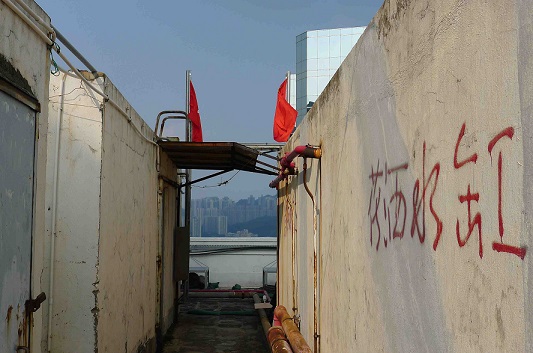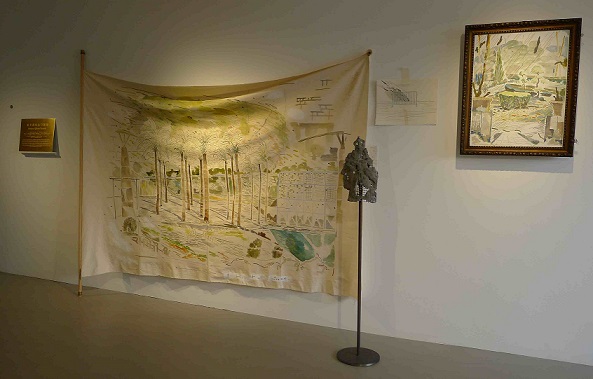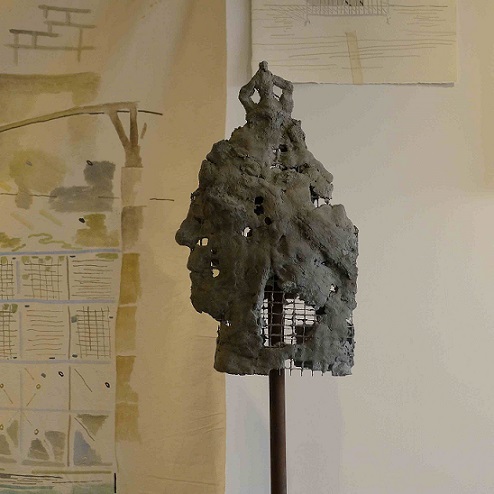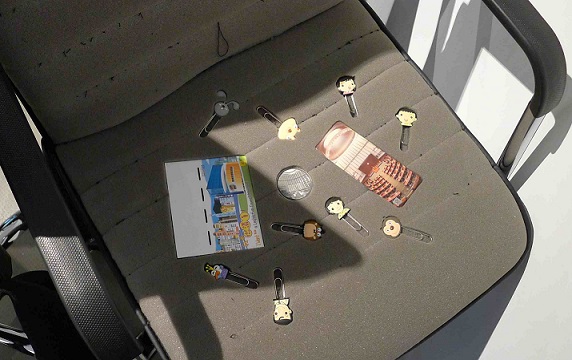Reviews & Articles
Imagine there’s no country / Above us only our cities
John BATTEN
at 3:31pm on 19th October 2015





Captions:
1. Luke Ching Chin Wai, Matrix, video, 1min 32seconds, 2015.
2. Lam Hoi-sin, We are all Internet Americans, inkjet on fabric, 2015.
3. Ng Ka-chun, Two flags in-situ on Para Site's roof (the red signage on right-hand side labels the water tanks).
4. Chris Huen Sin-kan, Oh, Victoria, oil on canvas, ink & marker on paper, concrete, bronze, iron and a Hong Kong one dollar, 2015.
5. Chris Huen Sin-kan, Oh, Victoria, detail of installation, 2015.
(原文以英文發表,評論「如果只有城籍而沒有國籍」展。)
Relocated from Sheung Wan to North Point earlier this year and now in much slicker premises, this group exhibition is a return, of sorts, to Para Site’s 1990s origins. Reprising earlier concerns, this exhibition explores Hong Kong identity and gives a viewing opportunity for younger artists.
Para Site founders and now senior artists Leung Chi-wo, Sara Wong, Leung Mee-ping and Tsang Tak-ping previously explored identity at the interface of their colonial British upbringing and as Hong Kong Chinese. In this show, curator Jims Lam invites a similar exploration, but now set within the boundaries of the mainland’s considerable hegemony. Although Hong Kong’s colonial heritage explains and is responsible (or blamed) for the current workings of and thoughts about the city, it is the city’s current political and social relationship with the mainland that increasingly defines Hong Kong and its identity.
The eldest of the twelve participating artists, Luke Ching Chin-wai is a contemporary of Para Site’s founders and straddles previous generational understanding of the issue. His two contributions within the exhibition are pivotal. Displayed as a security-like panel, Ching harks back to Hong Kong’s ‘good old days’ by displaying seven CCTV monitors playing video images of familiar brand logos, such as TVB, KFC, Hello Kitty. After repeated playings, these logos ‘burn’ into the monitors’ black and white screens becoming indelible, like a photograph, like layers of innate learning.
Ng Ka Chun’s contribution is the most overt reference to last year’s Umbrella protests. He depicts miniature ‘iron horses’ or steel barricades, now ubiquitous at any street protest. These are placed within the exhibition and are also found chained to fences in surrounding streets. But, it is Ng’s discrete video monitor showing two equally-sized national and Hong Kong flying flags, significantly not of regulation dimensions, that gives this work subliminal power. The actual flags are placed on Para Site’s roof and this video link has an unsettling voyeuristic, surveillance intention. It mirrors Ching’s second video showing the artist blowing at, but unsuccessfully moving, a flying national flag.
Better known for his photography, Eason Tsang Ka Wai debuts his video work with Mopping. This depicts him mopping a tiled chan cha teng floor (probably the Silver Café in Wah Fu Estate). This simple, slowly performed action, sweeping past the floor’s rubbish, people’s legs, piled boxes, around tables and chairs, depicts a Hong Kong truism: the city navigating itself around our sovereign neighbour.
Lam Hoi Sin’s reminds us that nationalism is tempered by the realities of world membership. Her simple hanging cloth with the printed text, We are all Internet Americans, acknowledges the influence of U.S. technology, software and websites that homogenize the Internet world despite individual national characteristics.
Tang Kwok Hin’s installation of roughly stacked executive chairs stripped of their upholstery is deceptively subversive. Each chair’s foam padding has been reworked to be appliance packaging. Carefully inserted into expertly cut spaces are souvenirs that can be bought from the Legislative Council: ties, clips, glass paperweights. It is high mockery of Hong Kong’s administrative institutions.

Tang Kwok-hing, Cold Plank, office chairs, souvenirs from Legislative Council of the HKSAR, 2015.
The papercut Chinese newspaper installation of Elvis Yip Kin Boon combines remarkable irony and beauty. He cuts, in grid formation on large panels, a series of single Chinese character/photo combinations to reproduce an entire statement from the Central government warning that, “Anyone who is against the central government is not allowed to become chief executive…By appointing a chief executive who is opposed to the central government…would Hong Kong still maintain its glamour as the “Pearl of the Orient”?”
Nearby, the craggy sculptural head of Queen Victoria sits in front of Chris Huen Sin Kan’s elaborate mixed-media Victoria Park installation. Although, irrelevant and unknown, her continued presence confirms the resilience of Hong Kong’s past ideas about identity and that its “glamour” is not easily dimmed.
Link for further information:
The catalogue for this exhibition can be accessed here.
A version of this review was published in the South China Morning Post, 25 August 2015.
原文刊於《南華早報》,2015年8月25日。
